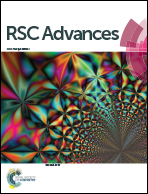Preparation of self-promoted hydroxy-containing phthalonitrile resins by an in situ reaction
Abstract
The in situ reaction of a hydroxy group with a phthalonitrile system was carried out by the simple nucleophilic displacement of a nitro-substituent from 4-nitrophthalonitrile in a dipolar aprotic solvent, in a one-pot reaction. The hydroxy-containing phthalonitrile system (HPBD) was prepared by mixing 4-hydroxyphenoxy phthalonitrile (HPPH) and 1,3-bis(3,4-dicyanophenoxy)benzene (BDB), followed by heating. The curing behavior was studied using differential scanning calorimetry and dynamic rheological analysis, and the results indicated that the HPBD exhibits a large processing window (∼75 °C) and low complex viscosity (0.1–1 Pa s) at moderate temperatures. Fourier transform infrared spectroscopy (FT-IR) showed that polytriazine, polyindoline and phthalocyanine structures were formed during polymerization, and that the introduction of HPPH facilitated the curing reaction. Additionally, the prepared HPBD polymers showed outstanding thermal stability, a high modulus and a high glass transition temperature (Tg). After curing at 300 °C, the Tg of HPBD resin was raised to 410 °C. Postcuring effects on the thermal and dynamic mechanical properties were evaluated using thermogravimetric analysis (TGA) and dynamic mechanical analysis (DMA).


 Please wait while we load your content...
Please wait while we load your content...